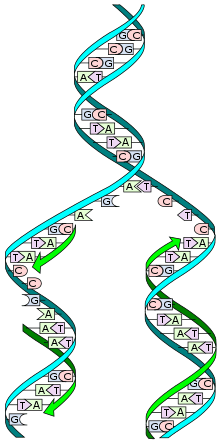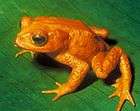De-extinction
De-extinction, also known as resurrection biology, or species revivalism, is the process of generating an organism that is either an extinct species or resembles an extinct species.[1] There are several ways to carry out the process of de-extinction. Cloning is the most widely proposed method, although genome editing and selective breeding have also been considered. Similar techniques have been applied to certain endangered species, in hopes to boost populations. The only method of the three that would provide an animal with the same genetic identity is cloning.[2] There are both pros and cons to the process of de-extinction ranging from technological advancements to ethical issues.
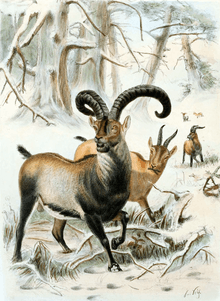
Methods
Cloning
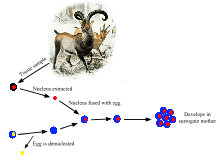
Cloning is a commonly suggested method for the potential restoration of an extinct species. It can be done by extracting the nucleus from a preserved cell from the extinct species and swapping it into an egg, without a nucleus, of that species' nearest living relative.[3] The egg can then be inserted into a host from the extinct species’ nearest living relative. It is important to note that this method can only be used when a preserved cell is available, meaning it would be most feasible for recently extinct species.[4] Cloning has been used in science since the 1950s.[5] One of the most well known clones is Dolly, the sheep. Dolly was born in the mid 1990s and lived a normal life until she experienced health complications that led to her death.[5] Other animal species known to have been cloned include dogs, pigs, and horses.[5]
Genome editing
Genome editing has been rapidly advancing with the help of the CRISPR/Cas systems, particularly CRISPR/Cas9. The CRISPR/Cas9 system was originally discovered as part of the bacterial immune system.[6] Viral DNA that was injected into the bacterium became incorporated into the bacterial chromosome at specific regions. These regions are called clustered regularly interspaced short palindromic repeats, otherwise known as CRISPR. Since the viral DNA is within the chromosome, it gets transcribed into RNA. Once this occurs, the Cas9 binds to the RNA. Cas9 can recognize the foreign insert and cleaves it.[6] This discovery was very crucial because now the Cas protein can be viewed as a scissor in the genome editing process.
By using cells from a closely related species to the extinct species, genome editing can play a role in the de-extinction process. Germ cells may be edited directly, so that the egg and sperm produced by the extant parent species will produce offspring of the extinct species, or somatic cells may be edited and transferred via somatic cell nuclear transfer. This results in a hybrid between the two species, since it is not completely one animal. Because it is possible to sequence and assemble the genome of extinct organisms from highly degraded tissues, this technique enables scientists to pursue de-extinction in a wider array of species, including those for which no well-preserved remains exist.[3] However, the more degraded and old the tissue from the extinct species is, the more fragmented the resulting DNA will be, making genome assembly more challenging.
Back breeding
Back breeding is a form of selective breeding. As opposed to breeding animals for a trait to advance the species in selective breeding, back breeding involves breeding animals for an ancestral characteristic that may not be seen throughout the species as frequently.[7] This method can recreate the traits of an extinct species, but the genome will differ from the original species.[4] Back breeding, however, is contingent on the ancestral trait of the species still being in the population in any frequency.[7]
Iterative evolution
A natural process of de-extinction is iterative evolution. This process occurs when a species becomes extinct, but then reappears after some amount of time. An example of this process occurred with the white-throated rail. This flightless bird became extinct approximately 136,000 years ago due to an unknown event that caused sea levels to rise, which resulted in the demise of the species. The species reappeared about 100,000 years ago when sea levels dropped, allowing the bird to evolve once again as a flightless species on the island of Aldabra, where it is found to the present day.[8][9][10] Also see Elvis taxon.
Advantages of de-extinction
The technologies being developed for de-extinction could lead to large advancements in scientific technology and process. This includes the advancement of genetic technologies that are used to improve the cloning process for de-extinction. The technologies could be used to prevent endangered species from going extinct.[11] The study of reintroduced species could also lead to advancements in science. By studying previously extinct animals, cures to diseases could be discovered. Revived species may support conservation initiatives by acting as "flagship species" to generate public enthusiasm and funds for conserving entire ecosystems.[12][13]
If de-extinction is prioritized it would lead to the improvement of current conservation strategies. Conservation would be necessary in order to reintroduce a species into the ecosystem. Conservation efforts would be taken initially until the revived population can sustain itself in the wild.[14] De-extinction could also help improve ecosystems that had been destroyed by human development by introducing an extinct species back into an ecosystem to revive it. It is also a question of if revive species that humans drove to extinction is required to right humanity’s wrong in driving a species into extinction to begin with.[15]
Disadvantages of de-extinction
The reintroduction of extinct species could have a negative impact on extant species and their ecosystem. Reintroducing an extinct species into its former ecosystem could now be seen as classifying it as being an invasive species. This could lead to the extinction of living species due to competition for food or other competitive exclusion. It could also lead to the extinction of prey species if they have more predators in an environment that had few predators before the reintroduction of an extinct species.[16] If a species has been extinct for a long period of time the environment they are introduced to could be wildly different from the one that they can survive in. The changes in the environment due to human development could mean that the species may not survive if reintroduced into that ecosystem.[17] A species could also become extinct again after de-extinction if the reasons for its extinction are still a threat. The woolly mammoth would be hunted by poachers just like elephants for their ivory and could go extinct again if this were to happen. Or, if a species is reintroduced into an environment with disease it has no immunity to the reintroduced species could be wiped out by a disease that current species can survive.
De-extinction is a very expensive process. Bringing back one species can cost millions of dollars. The money for de-extinction would most likely come from current conservation efforts. These efforts could be weakened if funding is taken from conservation and put into de-extinction. This would mean that critically endangered species would start to go extinct faster because there are no longer resources that are needed to maintain their populations.[18] Also since cloning techniques will never produce a species completely identical to the extinct one the reintroduction of the species may not have the environment benefits that conservationists hope it would. They may not have the same role in the food chain that they did before and therefore cannot restore damaged ecosystems.[19] It is also criticized as an act of playing god.
Current candidates for de-extinction
_-_Mauricio_Ant%C3%B3n.jpg)
Woolly mammoth
The existence of preserved soft tissue remains and DNA from woolly mammoths has led to the idea that the species could be recreated by scientific means. Two methods have been proposed to achieve this. The first would be to use the cloning process, because even the most intact mammoths have had little usable DNA because of their conditions of preservation. There is not enough DNA intact to guide the production of an embryo.[20] The second method involves artificially inseminating an elephant egg cell with preserved sperm of the mammoth. The resulting offspring would be an elephant–mammoth hybrid. After several generations of cross-breeding these hybrids, an almost pure woolly mammoth could be produced. However, sperm cells of modern mammals are typically potent for up to 15 years after deep-freezing, which could hinder this method.[21] In 2008, a Japanese team found usable DNA in the brains of mice that had been frozen for 16 years. They hope to use similar methods to find usable mammoth DNA.[22] In 2011, Japanese scientists announced plans to clone mammoths within six years.[23]
In March 2014, the Russian Association of Medical Anthropologists reported that blood recovered from a frozen mammoth carcass in 2013 would now provide a good opportunity for cloning the woolly mammoth.[21] Another way to create a living woolly mammoth would be to migrate genes from the mammoth genome into the genes of its closest living relative, the Asian elephant, to create hybridized animals with the notable adaptations that it had for living in a much colder environment than modern day elephants. This is currently being done by a team led by Harvard geneticist George Church.[24] The team has made changes in the elephant genome with the genes that gave the woolly mammoth its cold-resistant blood, longer hair, and extra layer of fat.[24] According to geneticist Hendrik Poinar, a revived woolly mammoth or mammoth-elephant hybrid may find suitable habitat in the tundra and taiga forest ecozones.[25]
George Church has hypothesized the positive effects of bringing back the extinct woolly mammoth would have on the environment, such as the potential for reversing some of the damage caused by global warming.[26] He and his fellow researchers predict that mammoths would eat the dead grass allowing the sun to reach the spring grass; their weight would allow them to break through dense, insulating snow in order to let cold air reach the soil; and their characteristic of felling trees would increase the absorption of sunlight.[26] In an editorial condemning de-extinction, Scientific American pointed out that the technologies involved could have secondary applications, specifically to help species on the verge of extinction regain their genetic diversity.[27]
Pyrenean ibex
The Pyrenean ibex was a subspecies of Spanish ibex that roamed on the Iberian peninsula. While it was abundant up to the Medieval times, over-hunting in the 19th and 20th centuries led to its demise. In 1999, only a single female named Celia was left alive in Ordesa National Park. Scientists captured her, took a tissue sample from her ear, collared her, then released her back into the wild, where she lived until she was found dead in 2000, having been crushed by a fallen tree. In 2003, scientists used the tissue sample to attempt to clone Celia and resurrect the extinct subspecies. Despite having successfully transferred nuclei from her cells into domestic goat egg cells and impregnating 208 female goats, only one came to term. The baby ibex that was born had a lung defect, and lived for only 7 minutes before suffocating from being incapable of breathing oxygen. Nevertheless, her birth was seen as a triumph and has been considered to have been the first de-extinction.[28] In late 2013, scientists announced that they would again attempt to recreate the Pyrenean ibex. A problem to be faced, in addition to the many challenges of reproduction of a mammal by cloning, is that only females can be produced by cloning the female individual Celia, and no males exist for those females to reproduce with. This could potentially be addressed by breeding female clones with the closely related Southeastern Spanish ibex, and gradually creating a hybrid animal that will eventually bear more resemblance to the Pyrenean ibex than the Southeastern Spanish ibex.[29]
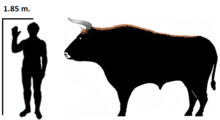
Aurochs
The aurochs was widespread across Eurasia, North Africa, and the Indian subcontinent during the Pleistocene, but only the European aurochs (Bos primigenius primigenius) survived into historic times.[30] This species is heavily featured in European cave paintings, such as Lascaux and Chauvet cave in France,[31] and was still widespread during the Roman era. Following the fall of the Roman empire, overhunting of the aurochs by nobility caused its population to dwindle to a single population in the Jaktorów forest in Poland, where the last wild one died in 1627.[32] However, because the aurochs is ancestral to most modern cattle breeds, it is possible for it to be brought back through selective or back breeding. The first attempt at this was by Heinz and Lutz Heck using modern cattle breeds, which resulted in the creation of Heck cattle. This breed has been introduced to nature preserves across Europe; however, it differs strongly from the aurochs in both physical characteristics and behavior, and modern attempts have tried to create an animal that is nearly identical to the aurochs in morphology, behavior, and even genetics.[33] The TaurOs Project aims to recreate the aurochs through selectively breeding primitive cattle breeds over a course of twenty years to create a self-sufficient bovine grazer in herds of at least 150 animals in rewilded nature areas across Europe.[34] This organization is partnered with the organization Rewilding Europe to help restore balance to European nature.[35] A competing project to recreate the aurochs is the Uruz Project by the True Nature Foundation, which aims to recreate the aurochs through a more efficient breeding strategy and through genome editing, in order to decrease the number of generations of breeding needed and the ability to quickly eliminate undesired traits from the new aurochs population.[36] It is hoped that the new aurochs will reinvigorate European nature by restoring its ecological role as a keystone species, and bring back biodiversity that disappeared following the decline of European megafauna, as well as helping to bring new economic opportunities related to European wildlife viewing.[37]
Quagga
The quagga (Equus quagga quagga) is a subspecies of the plains zebra that was distinct in that it was striped on its face and upper torso, but its rear abdomen was a solid brown. It was native to South Africa, but was wiped out in the wild due to overhunting for sport, and the last individual died in 1883 in the Amsterdam Zoo.[38] However, since it is technically the same species as the surviving plains zebra, it has been argued that the quagga could be revived through artificial selection. The Quagga Project aims to recreate the animal through the selective or back breeding of plains zebras.[39] It also aims to release these animals onto the western Cape once an animal that fully resembles the quagga is achieved, which could have the benefit of eradicating non-native trees.[40]
Thylacine
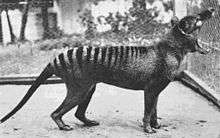
The thylacine was native to the Australian mainland, Tasmania and New Guinea. It is believed to have become extinct in the 20th century. The thylacine had become extremely rare or extinct on the Australian mainland before British settlement of the continent. The last known thylacine, named Benjamin, died at the Hobart Zoo, on September 7, 1936. It is believed to have died as the result of neglect—locked out of its sheltered sleeping quarters, it was exposed to a rare occurrence of extreme Tasmanian weather: extreme heat during the day and freezing temperatures at night.[41] Official protection of the species by the Tasmanian government was introduced on July 10, 1936, roughly 59 days before the last known specimen died in captivity.[42]
In December 2017 it was announced in Nature Ecology and Evolution that the full nuclear genome of the thylacine had been successfully sequenced, marking the completion of the critical first step toward de-extinction that began in 2008, with the extraction of the DNA samples from the preserved pouch specimen.[43] The Thylacine genome was reconstructed by using the genome editing method. The Tasmanian devil was used as a reference for the assembly of the full nuclear genome.[44] Andrew J. Pask from the University of Melbourne has stated that the next step toward de-extinction will be to create a functional genome, which will require extensive research and development, estimating that a full attempt to resurrect the species may be possible as early as 2027.[43]
Passenger pigeon
_(14562557107).jpg)
The passenger pigeon numbered in the billions before being wiped out due to commercial hunting and habitat loss. The non-profit Revive & Restore obtained DNA from the passenger pigeon from museum specimens and skins; however, this DNA is degraded because it is so old. For this reason, simple cloning would not be an effective way to perform de-extinction for this species because parts of the genome would be missing. Instead, Revive & Restore focuses on identifying mutations in the DNA that would cause a phenotypic difference between the extinct passenger pigeon and its closest living relative the band-tailed pigeon. In doing this, they can determine how to modify the DNA of the band-tailed pigeon to change the traits to mimic the traits of the passenger pigeon. In this sense, the de-extinct passenger pigeon would not be genetically identical to the extinct passenger pigeon, but it would have the same traits. The de-extinct passenger pigeon hybrid is expected to be ready for captive breeding by 2024 and released into the wild by 2030.[45]
Future potential candidates for de-extinction
Birds
- Moa – this group of large (up to 4 m [12 ft] tall and 110 kg [250 lb]), flightless birds became extinct in approximately 1400 AD following the arrival and proliferation of the Maori people on New Zealand; however, intact DNA from both preserved specimens and eggshells makes the moa a candidate for resurrection.[46] New Zealand politician Trevor Mallard has suggested bringing back a medium-sized species.[47]
- Heath hen – this subspecies of the prairie chicken became extinct on Martha's Vineyard in 1932 despite conservation efforts; however, the availability of usable DNA in museum specimens and protected areas in its former range makes this bird a possible candidate for de-extinction and reintroduction to its former habitat.[48]
- Dodo – this large, flightless ground bird endemic to Mauritius was last sighted in the 1640s and was most likely extinct by 1700, due to exploitation by humans and due to introduced species such as rats and pigs, which ate their eggs, and has since become a symbol of extinction in popular culture. Due to a wealth of bones and some tissues, it is possible that this species may live again as it has a close relative in the surviving Nicobar pigeon.[49] The entire dodo bird genome has been sequenced, but further steps towards de-extinction have not yet been made.[50]
- Elephant bird – of the largest birds to have ever existed, the elephant bird was driven to extinction by the early colonization of Madagascar. Ancient DNA has been obtained from the eggshells but may be too degraded for use in de-extinction.[51]
- Carolina Parakeet
- Great Auk
- Cuban Macaw
- Labrador Duck
- Huia
- Moho
- Haast's eagle
Mammals
- Caribbean monk seal
- Irish elk
- Japanese sea lion
- Cave lion – The discovery of two preserved cubs in the Sakha Republic ignited a project to clone the animal.[52]
- Steppe bison – The discovery of the mummified steppe bison of 9,000 years ago could help people clone the ancient bison species back, even though the steppe bison would not be the first to be "resurrected".[53]
- Tarpan – A subspecies of wild horse that went extinct in 1909. Much like the aurochs, there have been many attempts to breed tarpan-like horses, the first being by the Heck brothers, creating the Heck horse as a result. Though it is not a genetic copy, it is claimed to bear many similarities to the tarpan.[54] Other attempts were made to create tarpan-like horses. A breeder named Harry Hegardt was able to breed a line of horses from American Mustangs.[55] Other breeds of tarpan-like horse include the Konik and Strobel's horse.
- Woolly rhinoceros – Similar reasons of bringing back as the woolly mammoth.
- Macrauchenia – The DNA of Macrauchenia, which has been discovered in 2017, makes it possible for Macrauchenia to be cloned.[56]
- Mylodon - The DNA of Mylodon, which still persists, makes it likely for Mylodon to one day be cloned by scientists[57]
- Smilodon[58]
- Hippidion
- Steller's Sea Cow
- Caspian Tiger
- Falkland Islands wolf
- Shasta ground sloth[59]
- American lion[60]
- Short-faced bear
- Bluebuck
- Syrian wild ass
- Caucasian wisent
- Doedicurus[61]
Reptiles
- Floreana Island tortoise – In 2008, mitochondrial DNA from the Floreana tortoise species was found in museum specimens. In theory, a breeding programme could be established to "resurrect" a pure Floreana species from living hybrids.[62][63]
- Hoplodactylus delcourti
Amphibians
- Gastric-brooding frog – In 2013, scientists in Australia successfully created a living embryo from non-living preserved genetic material, and hopes by using somatic-cell nuclear transfer methods, they can produce an embryo that can survive to the tadpole stage.[64]
See also
References
- Yin, Steph (20 March 2017). "We Might Soon Resurrect Extinct Species. Is It Worth the Cost?". New York Times. Retrieved 20 March 2017.
- Sherkow, Jacob. "What If Extinction Is Not Forever?".
- Shapiro, Beth (2016-08-09). "Pathways to de-extinction: how close can we get to resurrection of an extinct species?". Functional Ecology. 31 (5): 996–1002. doi:10.1111/1365-2435.12705. ISSN 0269-8463. S2CID 15257110.
- "Should we bring extinct species back from the dead?". Science | AAAS. 2016-09-23. Retrieved 2018-04-30.
- Wadman, Meredith. "Dolly: A decade on".
- Palermo, Giulia; Ricci, Clarisse G.; McCammon, J. Andrew (April 2019). "The invisible dance of CRISPR-Cas9. Simulations unveil the molecular side of the gene-editing revolution". Physics Today. 72 (4): 30–36. doi:10.1063/PT.3.4182. ISSN 0031-9228. PMC 6738945. PMID 31511751.
- Shapiro, Beth (2017). "Pathways to de‐extinction: how close can we get to resurrection of an extinct species?". Functional Ecology. 31 (5): 996–1002. doi:10.1111/1365-2435.12705. S2CID 15257110.
- The bird that came back from the dead
- Extinct species of bird came back from the dead, scientists find
- This Bird Went Extinct and Then Evolved Into Existence Again
- "De-Extinction Debate: Should We Bring Back the Woolly Mammoth?". Yale E360. Retrieved 2020-04-29.
- Bennett, Joseph (25 March 2015). "Biodiversity gains from efficient use of private sponsorship for flagship species conservation". Proceedings of the Royal Society. 282 (1805): 20142693. doi:10.1098/rspb.2014.2693. PMC 4389608. PMID 25808885.
- Whittle, Patrick; et al. (12 Dec 2014). "Re-creation tourism: de-extinction and its implications for nature-based recreation". Current Issues in Tourism. 18 (10): 908–912. doi:10.1080/13683500.2015.1031727.
- "The Pros and Cons of Reviving Extinct Animal Species | Plants And Animals". LabRoots. Retrieved 2020-04-29.
- Kasperbauer, T. J. (2017-01-02). "Should We Bring Back the Passenger Pigeon? The Ethics of De-Extinction". Ethics, Policy & Environment. 20 (1): 1–14. doi:10.1080/21550085.2017.1291831. ISSN 2155-0085.
- Kasperbauer, T. J. (2017-01-02). "Should We Bring Back the Passenger Pigeon? The Ethics of De-Extinction". Ethics, Policy & Environment. 20 (1): 1–14. doi:10.1080/21550085.2017.1291831. ISSN 2155-0085.
- "De-Extinction Debate: Should We Bring Back the Woolly Mammoth?". Yale E360. Retrieved 2020-04-29.
- "The Case Against De-Extinction: It's a Fascinating but Dumb Idea". Yale E360. Retrieved 2020-04-29.
- Richmond, Douglas J.; Sinding, Mikkel-Holger S.; Gilbert, M. Thomas P. (2016). "The potential and pitfalls of de-extinction". Zoologica Scripta. 45 (S1): 22–36. doi:10.1111/zsc.12212. ISSN 1463-6409.
- "We Could Resurrect the Woolly Mammoth. Here's How". National Geographic News. 2017-07-09. Retrieved 2020-04-28.
- "Welcome to Pleistocene Park: Russian scientists say they have a 'high chance' of cloning a woolly mammoth". PBS NewsHour. 2014-03-14. Retrieved 23 November 2014.
- "Mammoth Genome Project". Pennsylvania State University. Retrieved 18 March 2013.
- Lendon, B. (17 January 2011). "Scientists trying to clone, resurrect extinct mammoth". CNN. Retrieved 22 May 2013.
- "The Plan to Turn Elephants Into Woolly Mammoths Is Already Underway". Motherboard. 2014-05-21. Retrieved 23 November 2014.
- Hendrik Poinar. "Hendrik Poinar: Bring back the woolly mammoth! - Talk Video - TED.com". Ted.com. Retrieved 23 November 2014.
- Church, George. "George Church: De-Extinction Is a Good Idea." Scientific American. Scientific American, a Division of Nature America, Inc., 1 Sept. 2013. Web. 13 Oct. 2016.
- "Expiration Fate: Can "De-Extinction" Bring Back Lost Species?". Scientific American. Retrieved 2020-04-28.
- "First Extinct-Animal Clone Created". News.nationalgeographic.com. 2009-02-10. Retrieved 23 November 2014.
- Rincon, Paul (2013-11-22). "BBC News – Fresh effort to clone extinct animal". BBC News. Retrieved 23 November 2014.
- "Bos primigenius". IUCN Red List of Threatened Species. Retrieved 23 November 2014.
- "BBC Nature – Cattle and aurochs videos, news and facts". Bbc.co.uk. Retrieved 23 November 2014.
- Rokosz, Mieczyslaw (1995). "Cambridge Journals Online – Animal Genetic Resources / Resources génétiques animales / Recursos genéticos animales – Abstract – HISTORY OF THE AUROCHS (BOS TAURUS PRIMIGENIUS) IN POLAND". Animal Genetic Resources Information. 16: 5–12. doi:10.1017/S1014233900004582.
- "Jurassic Farm – Modern Farmer". Modern Farmer. 2014-09-10. Retrieved 23 November 2014.
- Bárbara Pais. "TaurOs Programme". Atnatureza.org. Archived from the original on 2014-10-06. Retrieved 23 November 2014.
- OKIA. "Tauros Programme". Rewildingeurope.com. Retrieved 23 November 2014.
- "Aurochs". Archived from the original on 2015-01-16. Retrieved 2015-07-08.
- OKIA. "The Aurochs – Born to be Wild". Rewildingeurope.com. Retrieved 23 November 2014.
- "ADW: Equus quagga: INFORMATION". Animal Diversity Web. Retrieved 23 November 2014.
- "OBJECTIVES :: The Quagga Project :: South Africa". Quaggaproject.org. Archived from the original on 1 December 2014. Retrieved 23 November 2014.
- Harley, Eric H.; Knight, Michael H.; Lardner, Craig; Wooding, Bernard; Gregor, Michael (2009). "The Quagga Project: Progress over 20 Years of Selective Breeding". South African Journal of Wildlife Research. 39 (2): 155–163. CiteSeerX 10.1.1.653.4113. doi:10.3957/056.039.0206.
- Paddle (2000), p. 195.
- "National Threatened Species Day". Department of the Environment and Heritage, Australian Government. 2006. Archived from the original on July 9, 2009. Retrieved 21 November 2006.
- "Tasmanian Tiger Genome May Be First Step Toward De-Extinction". 2017-12-11. Retrieved 2018-08-25.
- Feigin, Charles Y.; Newton, Axel H.; Doronina, Liliya; Schmitz, Jürgen; Hipsley, Christy A.; Mitchell, Kieren J.; Gower, Graham; Llamas, Bastien; Soubrier, Julien (2018). "Genome of the Tasmanian tiger provides insights into the evolution and demography of an extinct marsupial carnivore". Nature Ecology & Evolution. 2 (1): 182–192. doi:10.1038/s41559-017-0417-y. ISSN 2397-334X. PMID 29230027.
- "Passenger Pigeon Comeback – Revive & Restore". Revive & Restore. 2015-06-09. Retrieved 30 April 2018.
- "Pictures: Extinct Species That Could Be Brought Back". National Geographic. 2013-03-06. Retrieved 23 November 2014.
- "Time to bring back... the moa". Stuff. Retrieved 23 November 2014.
- "Heath Hen Debate Contains Vineyard DNA". The Vineyard Gazette – Martha's Vineyard News. Retrieved 23 November 2014.
- "Pictures: Extinct Species That Could Be Brought Back". National Geographic. 2013-03-06. Retrieved 23 November 2014.
- "Dodo Bird De-extinction? The Dialogue Has Begun in the Island Nation of Mauritius | Revive & Restore". reviverestore.org. 2016-12-19. Retrieved 2018-04-30.
- Alleyne, Richard (10 March 2010). "Extinct elephant bird of Madagascar could live again". Telegraph.co.uk.
- "Scientists to clone Ice Age cave lion". NewsComAu. 5 March 2016.
- "9,000-year-old bison found mummified in Siberia". techtimes.com. 6 November 2014.
- "Breeds of Livestock - Tarpan Horse — Breeds of Livestock, Department of Animal Science". afs.okstate.edu.
- "The Daily Courier - Google News Archive Search". news.google.com.
- Strickland, Ashley (June 27, 2017). "DNA solves ancient animal riddle that Darwin couldn't". CNN. Retrieved January 23, 2020.
- Poulakakis, N.; Glaberman, S.; Russello, M.; Beheregaray, L. B.; Ciofi, C.; Powell, J. R.; Caccone, A. (2008-10-07). "Historical DNA analysis reveals living descendants of an extinct species of Galápagos tortoise". Proceedings of the National Academy of Sciences. 105 (40): 15464–15469. doi:10.1073/pnas.0805340105. PMC 2563078. PMID 18809928.
- Ludden, Maizy (2017-11-12). "Extinct tortoise species may return to the Galápagos thanks to SUNY-ESF professor - The Daily Orange - The Independent Student Newspaper of Syracuse, New York". The Daily Orange. Retrieved 2018-06-04.
- "Scientists successfully create living embryo of an extinct species".
Further reading
- O'Connor, M.R. (2015). Resurrection Science: Conservation, De-Extinction and the Precarious Future of Wild Things. New York: St. Martin's Press. ISBN 9781137279293. Archived from the original on 2016-07-04.
- Shapiro, Beth (2015). How to Clone a Mammoth: The Science of De-Extinction. Princeton, NJ: Princeton University Press. ISBN 9780691157054.
- Pilcher, Helen (2016). Bring Back the King: The New Science of De-extinction. Bloomsbury Press ISBN 9781472912251
External links
- TEDx DeExtinction March 15, 2013 conference sponsored by Revive and Restore project of the Long Now Foundation, supported by TEDx and hosted by the National Geographic Society, that helped popularize the public understanding of the science of de-extinction. Video proceedings, meeting report, and links to press coverage freely available.
- De-Extinction: Bringing Extinct Species Back to Life April 2013 article by Carl Zimmer for National Geographic magazine reporting on 2013 conference.
